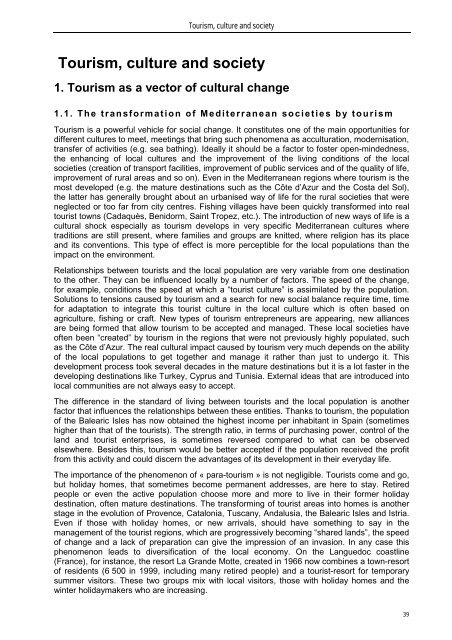dossier sur le tourisme et le développement durable
dossier sur le tourisme et le développement durable
dossier sur le tourisme et le développement durable
You also want an ePaper? Increase the reach of your titles
YUMPU automatically turns print PDFs into web optimized ePapers that Google loves.
Tourism, culture and soci<strong>et</strong>y<br />
Tourism, culture and soci<strong>et</strong>y<br />
1. Tourism as a vector of cultural change<br />
1.1. The transformation of Mediterranean soci<strong>et</strong>ies by tourism<br />
Tourism is a powerful vehic<strong>le</strong> for social change. It constitutes one of the main opportunities for<br />
different cultures to me<strong>et</strong>, me<strong>et</strong>ings that bring such phenomena as acculturation, modernisation,<br />
transfer of activities (e.g. sea bathing). Ideally it should be a factor to foster open-mindedness,<br />
the enhancing of local cultures and the improvement of the living conditions of the local<br />
soci<strong>et</strong>ies (creation of transport facilities, improvement of public services and of the quality of life,<br />
improvement of rural areas and so on). Even in the Mediterranean regions where tourism is the<br />
most developed (e.g. the mature destinations such as the Côte d’Azur and the Costa del Sol),<br />
the latter has generally brought about an urbanised way of life for the rural soci<strong>et</strong>ies that were<br />
neg<strong>le</strong>cted or too far from city centres. Fishing villages have been quickly transformed into real<br />
tourist towns (Cadaquès, Benidorm, Saint Tropez, <strong>et</strong>c.). The introduction of new ways of life is a<br />
cultural shock especially as tourism develops in very specific Mediterranean cultures where<br />
traditions are still present, where families and groups are knitted, where religion has its place<br />
and its conventions. This type of effect is more perceptib<strong>le</strong> for the local populations than the<br />
impact on the environment.<br />
Relationships b<strong>et</strong>ween tourists and the local population are very variab<strong>le</strong> from one destination<br />
to the other. They can be influenced locally by a number of factors. The speed of the change,<br />
for examp<strong>le</strong>, conditions the speed at which a “tourist culture” is assimilated by the population.<br />
Solutions to tensions caused by tourism and a search for new social balance require time, time<br />
for adaptation to integrate this tourist culture in the local culture which is often based on<br />
agriculture, fishing or craft. New types of tourism entrepreneurs are appearing, new alliances<br />
are being formed that allow tourism to be accepted and managed. These local soci<strong>et</strong>ies have<br />
often been “created” by tourism in the regions that were not previously highly populated, such<br />
as the Côte d’Azur. The real cultural impact caused by tourism very much depends on the ability<br />
of the local populations to g<strong>et</strong> tog<strong>et</strong>her and manage it rather than just to undergo it. This<br />
development process took several decades in the mature destinations but it is a lot faster in the<br />
developing destinations like Turkey, Cyprus and Tunisia. External ideas that are introduced into<br />
local communities are not always easy to accept.<br />
The difference in the standard of living b<strong>et</strong>ween tourists and the local population is another<br />
factor that influences the relationships b<strong>et</strong>ween these entities. Thanks to tourism, the population<br />
of the Ba<strong>le</strong>aric Is<strong>le</strong>s has now obtained the highest income per inhabitant in Spain (som<strong>et</strong>imes<br />
higher than that of the tourists). The strength ratio, in terms of purchasing power, control of the<br />
land and tourist enterprises, is som<strong>et</strong>imes reversed compared to what can be observed<br />
elsewhere. Besides this, tourism would be b<strong>et</strong>ter accepted if the population received the profit<br />
from this activity and could discern the advantages of its development in their everyday life.<br />
The importance of the phenomenon of « para-tourism » is not negligib<strong>le</strong>. Tourists come and go,<br />
but holiday homes, that som<strong>et</strong>imes become permanent addresses, are here to stay. R<strong>et</strong>ired<br />
peop<strong>le</strong> or even the active population choose more and more to live in their former holiday<br />
destination, often mature destinations. The transforming of tourist areas into homes is another<br />
stage in the evolution of Provence, Catalonia, Tuscany, Andalusia, the Ba<strong>le</strong>aric Is<strong>le</strong>s and Istria.<br />
Even if those with holiday homes, or new arrivals, should have som<strong>et</strong>hing to say in the<br />
management of the tourist regions, which are progressively becoming “shared lands”, the speed<br />
of change and a lack of preparation can give the impression of an invasion. In any case this<br />
phenomenon <strong>le</strong>ads to diversification of the local economy. On the Languedoc coastline<br />
(France), for instance, the resort La Grande Motte, created in 1966 now combines a town-resort<br />
of residents (6 500 in 1999, including many r<strong>et</strong>ired peop<strong>le</strong>) and a tourist-resort for temporary<br />
summer visitors. These two groups mix with local visitors, those with holiday homes and the<br />
winter holidaymakers who are increasing.<br />
39
















